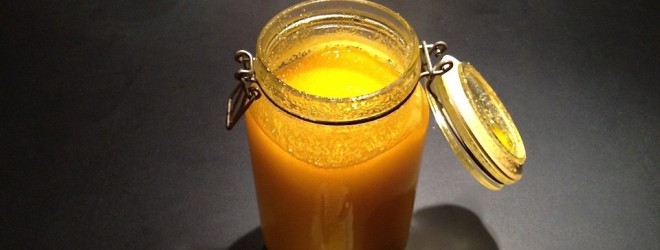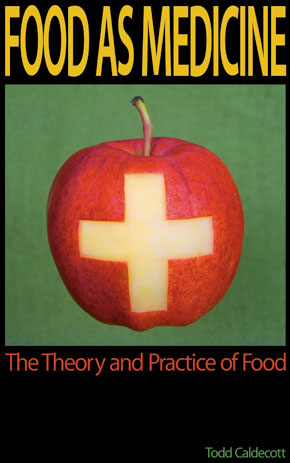Ghee is the classic cooking fat of ancient India, used not only in a variety of both sweet and savory dishes, but also as a medicine. The term ‘desi’ ghee means ‘home-made’ ghee, and originally referred to the pure, clarified oil rendered from cultured butter. Nowadays, most commercial ghee is made from non-cultured, creamery butter, and is not made according to the traditional, time-honored methods used in Indian villages for millennia. As such, this type of clarified butter does not have the virtues and benefits of traditionally made ghee. The difference is not only in the aroma and taste of the ghee, but in its chemical composition. From an Ayurvedic perspective, ghee made from cultured butter contains within it the quality of agni, which offsets the heavy and congesting properties of regular butter and clarified butter. To make proper ghee, always make it from unsalted, cultured butter.
Ingredients
2 lbs. (900 g) unsalted cultured butter
Directions
Melt the cultured butter in ceramic, glass or stainless steel pot, either in the oven at 250˚F/120˚C, or on low heat on the stove. Cook for 2-3 hours or so, until the butter separates into three distinct layers: a thin layer of impurities on the surface, the middle layer that contains the ghee, and the bottom layer which contains the milk solids. Take it off the heat and pour it off into a second bowl through a very fine mesh strainer or paper filter, leaving the congealed milk solids behind. Store the ghee in a dry glass container in a dark, cool location. To get the ghee out of the jar always use a clean dry spoon to avoid contamination and spoilage. Depending on the quality of the butter, this recipe will yield a little less than two pounds (750 g) of ghee.
In Ayurveda, ghee is a highly lauded food supplement, used to boost energy, improve the eyes, enhance the complexion, nourish the skin, balance the mind and nervous system, treat infertility and problems of pregnancy, counter deficiency (vata) and balance inflammation (pitta). When combined with other herbs it is said that ghee is ‘yogavahi’, meaning that it has the ability to augment the effects of any medicinal agent combined with it. Ghee is especially suited to children and the elderly, and is a rejuvenative in pitta conditions, often combined with honey for its nutritive effects, but never in equal quantities.
Shatadhauta is a type of ghee that has been kneaded in a copper vessel with very cold water, rinsed and then kneaded again with cold water – for ‘one hundred washings’. When prepared in this way the ghee becomes white like the moon, and is believed to have a cooling property, used in the treatment of burning sensations, skin disease, wounds, scars, and burns. When ghee has been aged in excess of ten years, called puraan ghee, it is thought to be much stronger in its overall action than fresh ghee, and when used as a medicine, balances all three doshas.
Sometimes I let my ghee cook for 3-4 hours, causing the proteins to congeal, making it easier to filter them out. It imparts a delightful nutty flavor to the ghee that is too amazing for words, and it would be great if it weren’t for the fact that these flavor compounds are generated through a Maillard reaction, which also results in the production of pro-oxidizing compounds, and thus isn’t so great for shelf life, and if you ate this all the time, not so good for health.


